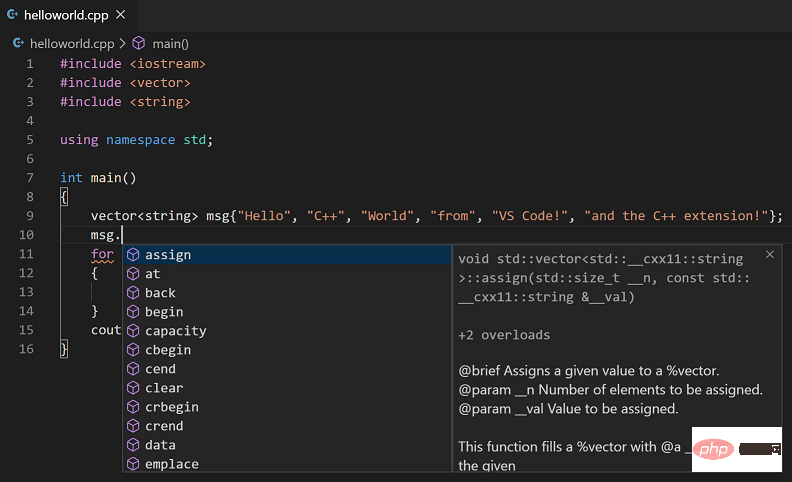
The hotel reservation system is an important information management system that can help hotels achieve more efficient management and better services. If you want to learn how to use C to write a simple hotel reservation system, then this article will provide you with a basic framework and detailed implementation steps.
- Functional requirements of the hotel reservation system
Before developing the hotel reservation system, we need to determine the functional requirements for its implementation. A basic hotel reservation system needs to implement at least the following functions:
(1) Room information management: including room type, room number, room price and other information.
(2) Customer information management: including customer name, contact information, reservation time, room number and other information.
(3) Reservation management: including functions such as customer reservation, cancellation of reservation, and reservation inquiry.
(4) Charge management: including customer checkout, bill inquiry and other functions.
- Design the data structure of the hotel reservation system
Before designing the data structure of the hotel reservation system, we need to first understand some basic data structure concepts, such as stacks and queues , linked list, etc. The stack is a data structure with "first in first out" characteristics, the queue is a data structure with "first in first out" characteristics, and the linked list is a data structure that uses connected nodes to organize data.
In the hotel reservation system, linked lists can be used to manage guest room and customer information, while queues and stacks can be used to implement reservation and charging operations. Specifically, you can define two linked lists to store guest room and customer information respectively, a queue to store reserved orders, and a stack to store checked out orders.
- Realize the main functions of the hotel reservation system
(1) Guest room information management
In the guest room information management function, you can define a Room class to Indicates information about each guest room. The Room class can include attributes such as room number, room type, room price, etc. It also needs to implement some methods for operating room information, such as adding rooms, deleting rooms, modifying room information, etc.
Code example:
class Room {
public:
int roomNumber; // 房间号 int roomType; // 房间类型 double roomPrice; // 房间价格
public:
Room(); Room(int number, int type, double price);
};
Room:: Room() {
roomNumber = 0; roomType = 0; roomPrice = 0.0;
}
Room::Room(int number, int type, double price) {
roomNumber = number; roomType = type; roomPrice = price;
}
(2) Customer information management
In the customer information management function, you can define a Customer class to represent each customer's information. The Customer class can include attributes such as customer name, contact information, booking time, room number, etc. It also needs to implement some methods for operating customer information, such as adding customers, deleting customers, modifying customer information, etc.
Code example:
class Customer {
public:
string name; // 客户姓名 string phoneNumber; // 客户联系方式 string bookDate; // 预订时间 int roomNumber; // 预订房间号
public:
Customer(); Customer(string name, string phoneNumber, string bookDate, int roomNumber);
};
Customer:: Customer() {
name = ""; phoneNumber = ""; bookDate = ""; roomNumber = 0;
}
Customer::Customer(string name, string phoneNumber, string bookDate, int roomNumber) {
this->name = name; this->phoneNumber = phoneNumber; this->bookDate = bookDate; this->roomNumber = roomNumber;
}
(3) Reservation management
In the reservation management function, you can define a Reservation class to represent the information of each reservation order. The Reservation class can include attributes such as customer name, contact information, reservation time, room number, etc. It also needs to implement some methods for operating reservation orders, such as adding orders, canceling orders, querying orders, etc.
Code example:
class Reservation {
public:
string name; // 客户姓名 string phoneNumber; // 客户联系方式 string startDate; // 预订开始时间 string endDate; // 预订结束时间 int roomNumber; // 预订房间号
public:
Reservation(); Reservation(string name, string phoneNumber, string startDate, string endDate, int roomNumber);
};
Reservation:: Reservation() {
name = ""; phoneNumber = ""; startDate = ""; endDate = ""; roomNumber = 0;
}
Reservation::Reservation(string name, string phoneNumber, string startDate, string endDate, int roomNumber) {
this->name = name; this->phoneNumber = phoneNumber; this->startDate = startDate; this->endDate = endDate; this->roomNumber = roomNumber;
}
(4) Charge management
In the charge management function, you can define a Billing class to represent each checked-out order information. The Billing class can include attributes such as customer name, contact information, check-in time, departure time, room number, room price, etc. It also needs to implement some methods for operating bills, such as adding bills, querying bills, etc.
Code example:
class Billing {
public:
string name; // 客户姓名 string phoneNumber; // 客户联系方式 string startDate; // 入住时间 string endDate; // 离开时间 int roomNumber; // 房间号 double roomPrice; // 房间价格
public:
Billing(); Billing(string name, string phoneNumber, string startDate, string endDate, int roomNumber, double roomPrice);
};
Billing:: Billing() {
name = ""; phoneNumber = ""; startDate = ""; endDate = ""; roomNumber = 0; roomPrice = 0.0;
}
Billing::Billing(string name, string phoneNumber, string startDate, string endDate, int roomNumber, double roomPrice) {
this->name = name; this->phoneNumber = phoneNumber; this->startDate = startDate; this->endDate = endDate; this->roomNumber = roomNumber; this->roomPrice = roomPrice;
}
- Write the main program of the hotel reservation system
In writing the main program of the hotel reservation system, you can use the data structure and function modules defined above to design the menu interface. By entering different instructions, different functional operations are achieved.
Code example:
int main() {
// 初始化客房信息和客户信息链表 // 初始化预订订单队列和结账订单栈 // 输出酒店预订系统操作菜单,等待用户指令 // 根据用户指令,调用相应的功能模块进行操作 return 0;
}
- Test hotel reservation system
After completing the writing of the hotel reservation system, some actual tests need to be carried out to verify whether its functions are correct, including adding, deleting, modifying and querying room information, customer information, reservation orders and checkout bills, etc., to ensure the normality of the entire system Operation and accuracy.
To sum up, this article introduces how to use C to write a simple hotel reservation system. Through the implementation of the above steps, you can further expand and optimize functions based on this to meet the needs of more different application scenarios.
The above is the detailed content of How to write a simple hotel reservation system using C++?. For more information, please follow other related articles on the PHP Chinese website!
 Windows 11 系统下的五款最佳免费 C++ 编译器推荐Apr 23, 2023 am 08:52 AM
Windows 11 系统下的五款最佳免费 C++ 编译器推荐Apr 23, 2023 am 08:52 AMC++是一种广泛使用的面向对象的计算机编程语言,它支持您与之交互的大多数应用程序和网站。你需要编译器和集成开发环境来开发C++应用程序,既然你在这里,我猜你正在寻找一个。我们将在本文中介绍一些适用于Windows11的C++编译器的主要推荐。许多审查的编译器将主要用于C++,但也有许多通用编译器您可能想尝试。MinGW可以在Windows11上运行吗?在本文中,我们没有将MinGW作为独立编译器进行讨论,但如果讨论了某些IDE中的功能,并且是DevC++编译器的首选
 C++报错:变量未初始化,应该如何解决?Aug 21, 2023 pm 10:01 PM
C++报错:变量未初始化,应该如何解决?Aug 21, 2023 pm 10:01 PM在C++程序开发中,当我们声明了一个变量但是没有对其进行初始化,就会出现“变量未初始化”的报错。这种报错经常会让人感到很困惑和无从下手,因为这种错误并不像其他常见的语法错误那样具体,也不会给出特定的代码行数或者错误类型。因此,下面我们将详细介绍变量未初始化的问题,以及如何解决这个报错。一、什么是变量未初始化错误?变量未初始化是指在程序中声明了一个变量但是没有
 C++编译错误:未定义的引用,该怎么解决?Aug 21, 2023 pm 08:52 PM
C++编译错误:未定义的引用,该怎么解决?Aug 21, 2023 pm 08:52 PMC++是一门广受欢迎的编程语言,但是在使用过程中,经常会出现“未定义的引用”这个编译错误,给程序的开发带来了诸多麻烦。本篇文章将从出错原因和解决方法两个方面,探讨“未定义的引用”错误的解决方法。一、出错原因C++编译器在编译一个源文件时,会将它分为两个阶段:编译阶段和链接阶段。编译阶段将源文件中的源码转换为汇编代码,而链接阶段将不同的源文件合并为一个可执行文
 如何优化C++开发中的文件读写性能Aug 21, 2023 pm 10:13 PM
如何优化C++开发中的文件读写性能Aug 21, 2023 pm 10:13 PM如何优化C++开发中的文件读写性能在C++开发过程中,文件的读写操作是常见的任务之一。然而,由于文件读写是磁盘IO操作,相对于内存IO操作来说会更为耗时。为了提高程序的性能,我们需要优化文件读写操作。本文将介绍一些常见的优化技巧和建议,帮助开发者在C++文件读写过程中提高性能。使用合适的文件读写方式在C++中,文件读写可以通过多种方式实现,如C风格的文件IO
 C++编译错误:无法为类模板找到实例化,应该怎么解决?Aug 21, 2023 pm 08:33 PM
C++编译错误:无法为类模板找到实例化,应该怎么解决?Aug 21, 2023 pm 08:33 PMC++是一门强大的编程语言,它支持使用类模板来实现代码的复用,提高开发效率。但是在使用类模板时,可能会遭遇编译错误,其中一个比较常见的错误是“无法为类模板找到实例化”(error:cannotfindinstantiationofclasstemplate)。本文将介绍这个问题的原因以及如何解决。问题描述在使用类模板时,有时会遇到以下错误信息:e
 iostream头文件的作用是什么Mar 25, 2021 pm 03:45 PM
iostream头文件的作用是什么Mar 25, 2021 pm 03:45 PMiostream头文件包含了操作输入输出流的方法,比如读取一个文件,以流的方式读取;其作用是:让初学者有一个方便的命令行输入输出试验环境。iostream的设计初衷是提供一个可扩展的类型安全的IO机制。
 C++语法错误:使用了未定义的命名空间,怎么处理?Aug 21, 2023 pm 09:49 PM
C++语法错误:使用了未定义的命名空间,怎么处理?Aug 21, 2023 pm 09:49 PMC++是一种广泛使用的高级编程语言,它有很高的灵活性和可扩展性,但同时也需要开发者严格掌握其语法规则才能避免出现错误。其中,常见的错误之一就是“使用了未定义的命名空间”。本文将介绍该错误的含义、出现原因和解决方法。一、什么是使用了未定义的命名空间?在C++中,命名空间是一种组织可重用代码的方式,以便保持代码的模块性和可读性。使用命名空间的方式可以使同名的函数
 C++中的信号处理技巧Aug 21, 2023 pm 10:01 PM
C++中的信号处理技巧Aug 21, 2023 pm 10:01 PMC++是一种流行的编程语言,它强大而灵活,适用于各种应用程序开发。在使用C++开发应用程序时,经常需要处理各种信号。本文将介绍C++中的信号处理技巧,以帮助开发人员更好地掌握这一方面。一、信号处理的基本概念信号是一种软件中断,用于通知应用程序内部或外部事件。当特定事件发生时,操作系统会向应用程序发送信号,应用程序可以选择忽略或响应此信号。在C++中,信号可以


Hot AI Tools

Undresser.AI Undress
AI-powered app for creating realistic nude photos

AI Clothes Remover
Online AI tool for removing clothes from photos.

Undress AI Tool
Undress images for free

Clothoff.io
AI clothes remover

AI Hentai Generator
Generate AI Hentai for free.

Hot Article

Hot Tools

Notepad++7.3.1
Easy-to-use and free code editor

PhpStorm Mac version
The latest (2018.2.1) professional PHP integrated development tool

SublimeText3 Mac version
God-level code editing software (SublimeText3)

EditPlus Chinese cracked version
Small size, syntax highlighting, does not support code prompt function

mPDF
mPDF is a PHP library that can generate PDF files from UTF-8 encoded HTML. The original author, Ian Back, wrote mPDF to output PDF files "on the fly" from his website and handle different languages. It is slower than original scripts like HTML2FPDF and produces larger files when using Unicode fonts, but supports CSS styles etc. and has a lot of enhancements. Supports almost all languages, including RTL (Arabic and Hebrew) and CJK (Chinese, Japanese and Korean). Supports nested block-level elements (such as P, DIV),





